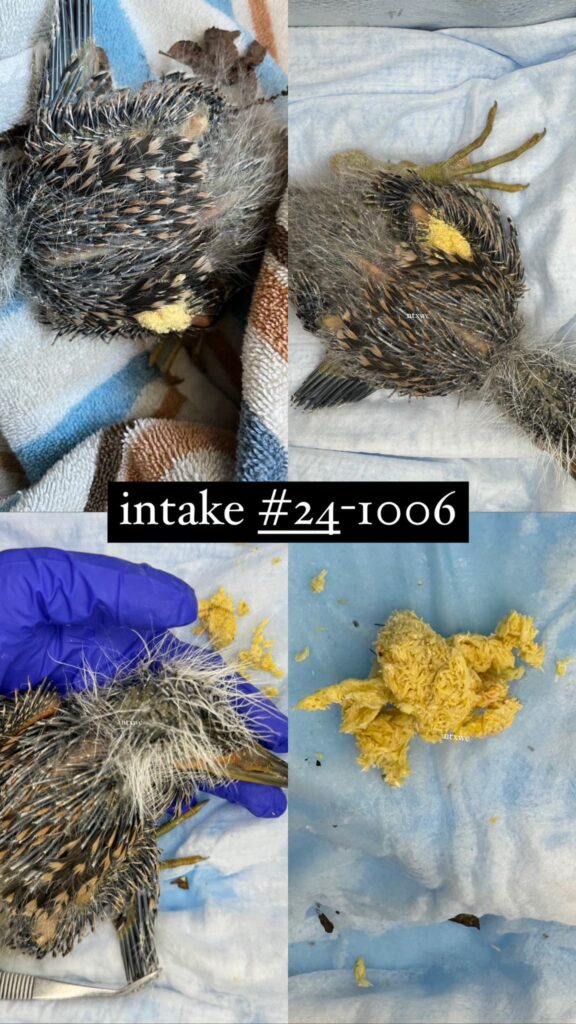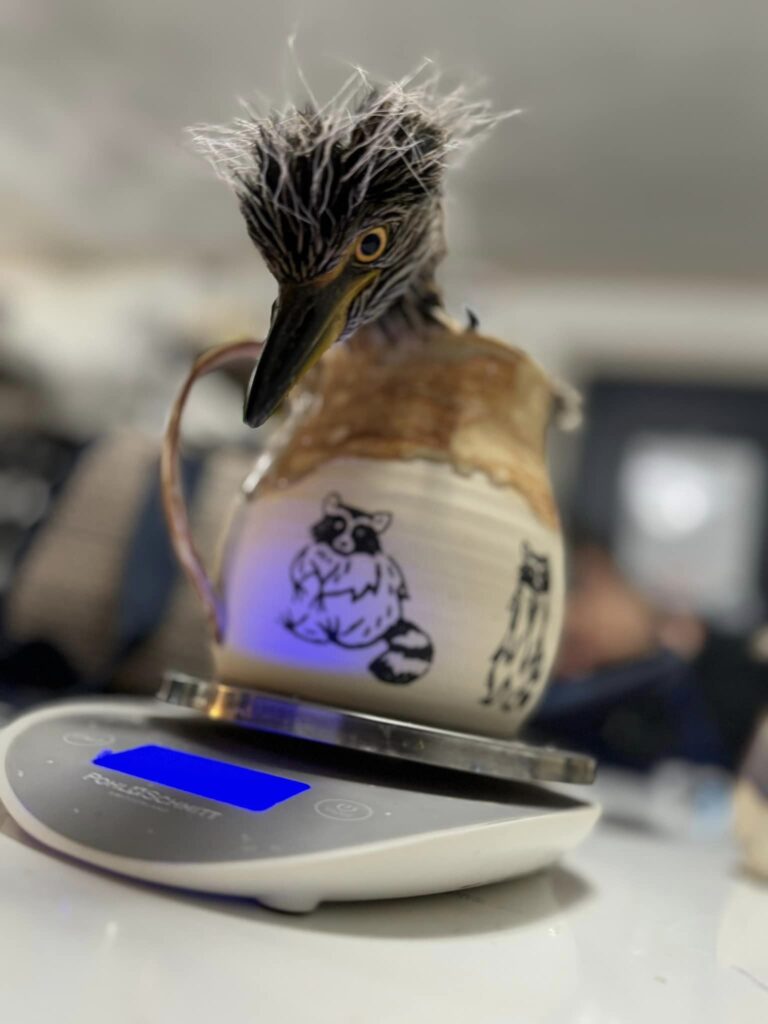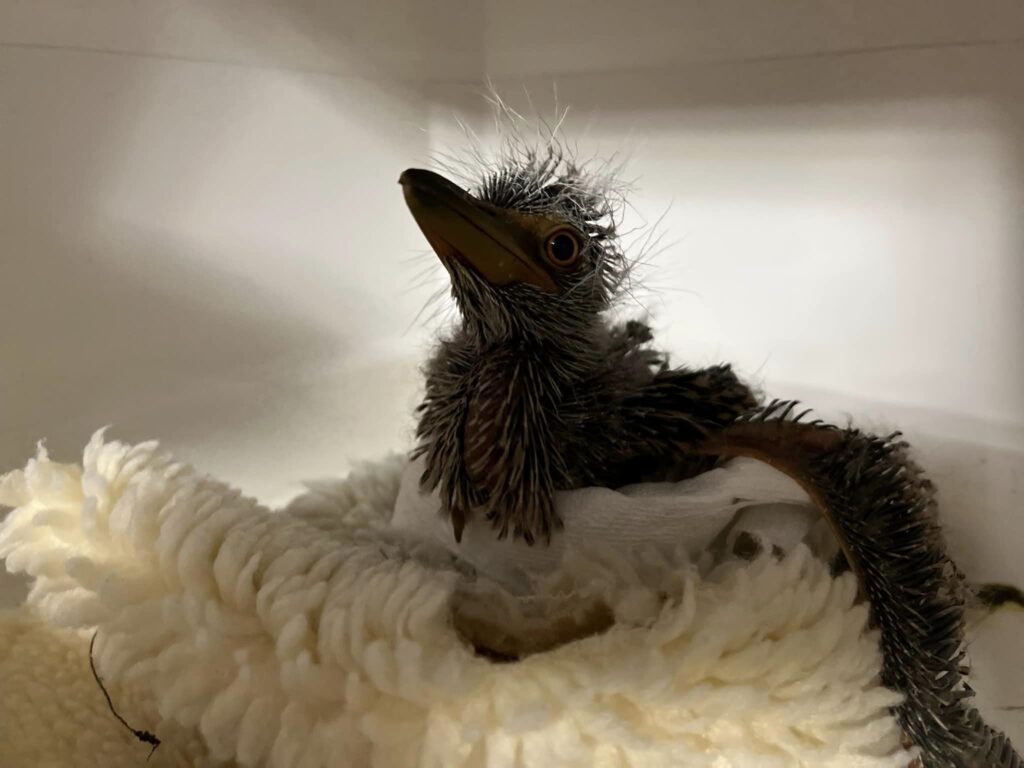Part V- Intake 24-1006
John W. Garbutt- Class of 2019
“So you don’t know about the bird names!” said Rose Ann. “It’s a Texas tradition.”
- From Kenn Kaufman’s Kingbird Highway
On May 20th, I hoped the young Yellow-crowned Night-Herons would be old enough to see peeking over the edge of their nests. I had not visited the 2023 main concentration area in a couple of weeks. Here, I first saw the pair tending chicks at the colony’s founding nest from 2022, but I could not locate the other nest. Scanning for signs of waste below after not locating the nest above, I located the area and climbed up the muddy bank. There alone, was an approximately three-week-old nestling Night-Heron on the ground.

I located the parents above, but they did not pay me, nor the nestling, any attention. The lack of parental behavior concerned me. I approached the young heron to check for signs of injury. It seemed healthy and alert. I found a discarded egg, along with crayfish shells. While assessing the situation, I sensed the prehistoric origins of modern birds when the young heron called and snapped. I felt the young heron, all things considered, was okay; but there was also a growing dread because no parents came down below. I then noticed the adults beginning to rebuild above, programmed from centuries of instinct to start a new nest when one is lost. I contacted Lauren about the situation, and she provided contact information for a rehab center that could provide help.
I retreated behind the height of the creek’s bank and knelt along the edge since the water was fairly low. I wanted to see if the parents would tend to the young bird. Had the nest fallen weeks ago with the adults continuing to feed to the young? There were signs of feeding around the young heron but that could have been discarded days or even a couple weeks previous. With recent storms, the limb may have recently broken. Watching the adults go through an abbreviated courtship process above, I felt the nest had possibly fallen during the storm a few days prior, and that the youngster had been recently abandoned.
I also located the nest sitting precariously on the edge of the bank where the creek began to fall 5-6 feet downstream. The preliminary conclusion was this was the only one who made it to safety as the others were swept away during the downpour. When spending time in nature, one comes across death, but these were “my” herons. Alone in a creek, thinking about what had transpired and battling my conflicting thoughts on what to do, I felt a sense of loss and sadness that I had not in nearly a decade as I wiped away a tear.
During this time, I heard from the North Texas Wildlife Center and planned to make daily observations. I did not want be one of those “kidnappers” who takes a young animal away from the parents or overburden a rehab center with an unnecessary patient. Before leaving, I made a final check on the heron who had moved a few feet to seek shelter under a limb. Flies swarmed it, and at that time, I saw the flies as only an annoyance to the young heron. Feeling I was in a Kobayashi Maru scenario, I made one of the most difficult decisions in my life. Despite thinking I made the right one, I went home with the lingering feeling I resigned the heron to certain death.
Returning home, I updated Lauren about my observations, the flies, along with seeing some yellow on the bird. I then realized I had made poor observations and was only focused on its behavior and not what was happening to it. I learned about fly strike, where flies lay eggs on a living organism resulting in the fly larva parasitizing the host animal causing fatal results. I sent the rehabbers an update and gathered a box, gloves, and towel to retrieve the heron.
Returning to the location, the heron now seemed weak and tired. Reaching through the swarming flies, I wrapped the heron in a blanket and placed in the box. We headed to the North Texas Wildlife Center. Waiting to be admitted, I told the heron it would soon be in capable hands. It snapped with healthy aggression providing a sense of hope.
The young heron became Intake 24-1006 admitted with fly strike. The hurried and dedicated team of the North Texas Wildlife Center got to work adding 24-1006 to their many charges. I never got their names, and l later looked them up online to make a donation.

The young heron undergoing flystrike removal. – Photo used courtesy of North Texas Wildlife Center


Intake 24-1006. Photos courtesy of North Texas Wildlife Center.
A special thank you to those mentioned in this article who rehab and rescue animals, and to all of those out there that volunteer, contribute, and treat wildlife and others with compassion.
Later recalling the day to Stacy, she said I was the herons’ “godfather” for always seeing them through nesting season.
“The second big thing that happened that evening was that I was christened with an official Texas bird name.”
- Kenn Kaufman’s Kingbird Highway


